
Saab AB, with subsidiaries collectively known as the Saab Group, is a Swedish aerospace and defence company primarily operating from Sweden. The company is headquartered in Stockholm, but its development and manufacturing operations are undertaken in Linköping.

The Saab JAS 39 Gripen is a light single-engine supersonic multirole fighter aircraft manufactured by the Swedish aerospace and defence company Saab AB. The Gripen has a delta wing and canard configuration with relaxed stability design and fly-by-wire flight controls. Later aircraft are fully NATO interoperable. As of 2020, more than 271 Gripens of all models, A–F, have been delivered.
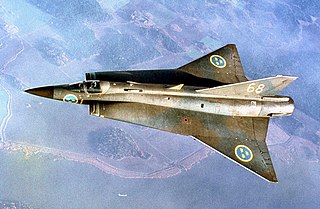
The Saab 35 Draken is a Swedish fighter-interceptor developed and manufactured by Svenska Aeroplan Aktiebolaget (SAAB) between 1955 and 1974. Development of the Saab 35 Draken started in 1948 as the Swedish air force future replacement for the then also in development Saab 29 Tunnan day fighter and Saab 32B Lansen all-weather fighter. It featured an innovative but unproven double delta wing, leading to the creation of a sub-scale test aircraft, the Saab 210, which was produced and flown to test this previously unexplored aerodynamic feature. The full-scale production version entered service with frontline squadrons of the Swedish Air Force on March 8, 1960. It was produced in several variants and types, most commonly as a fighter-interceptor.
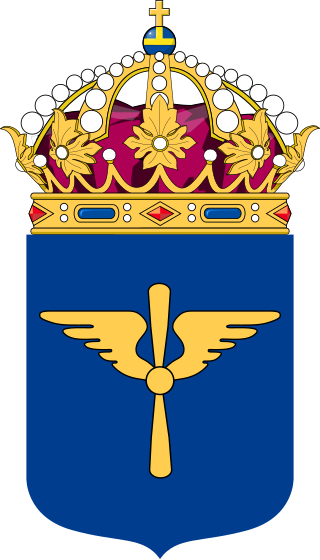
The Swedish Air Force is the air force branch of the Swedish Armed Forces.
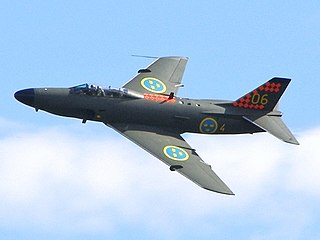
The Saab 32 Lansen is a two-seat, transonic military aircraft designed and manufactured by the Swedish aircraft manufacturer Saab AB.

The Saab 91 Safir is a three or four seater, single engine trainer aircraft. The Safir was built by Saab AB in Linköping, Sweden and by De Schelde in Dordrecht, Netherlands.

The Saab 105 is a Swedish high-wing, twinjet trainer aircraft developed in the early 1960s as a private venture by Saab AB. The Swedish Air Force, which had opted to procure the type for various roles, designated the aircraft SK 60. The SK 60 entered service in 1967, replacing the ageing De Havilland Vampire fleet.
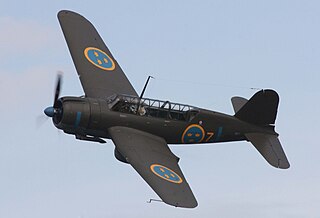
The Saab 17 is a Swedish single-engine monoplane reconnaissance dive-bomber aircraft of the 1940s originally developed by ASJA prior to its merger into Saab. It was the first all-metal stressed skin aircraft developed in Sweden.

The Saab 90 Scandia was a civil passenger aeroplane, manufactured by Svenska Aeroplan Aktiebolaget (SAAB), in Linköping, Sweden. In 1944, as it became clear that hostilities in Europe would soon end, SAAB realised that the company had to diversify from purely military endeavours if it were to survive. The board therefore decided to manufacture a twin-engined, short- to medium-haul passenger aircraft, as a successor for the Douglas DC-3.

Blekinge Wing, also F 17 Kallinge, or simply F 17, is a Swedish Air Force wing with the main base located near Ronneby in southern Sweden. The wing also operates the air base on the island of Gotland in the Baltic Sea. It is one of four wings in Sweden and currently has two squadrons of JAS-39 C/D fighter aircraft.
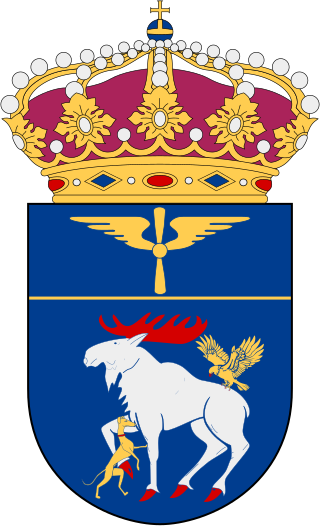
Jämtland Wing, also F 4 Frösön, or simply F 4, is a former Swedish Air Force wing with the main base located at Åre Östersund Airport outside Östersund on Frösön in the middle of Sweden.

Skaraborg Wing, also F 7 Såtenäs, or simply F 7, is a Swedish Air Force wing with the main base located near Lidköping in south-central Sweden.

Lieutenant General Sven-Olof Olson was a senior Swedish Air Force officer. He served as Commanding General of the Southern Military District from 1980 to 1982 and as Chief of the Air Force from 1982 to 1988.

Air Staff is the staff of the Chief of the Swedish Air Force. It was officially established in 1936 due to the Defence Act of 1936 and would handle matters of a general nature. The Air Staff's duties included, among other things, assisting the Chief of the Air Force with the leadership of the Air Force's mobilization, training, tactics, organization, equipment, and personnel to the extent that such activity was not directly related to operational activities, which the Defence Staff then handled. In 1994, the Swedish Armed Forces Headquarters took over the Air Staff's duties. In 2019, the Air Force Staff was re-established in Uppsala Garrison.

Lieutenant General Anders Tommy Silwer is a retired Swedish Air Force officer. His last position was as the Chief of Armed Forces Training & Procurement from 2014 to 2017.

Major General Mats Eric Helgesson is a retired Swedish Air Force officer. He served as commanding officer of the Blekinge Wing and as Chief of Air Force from 2015 to 2019.
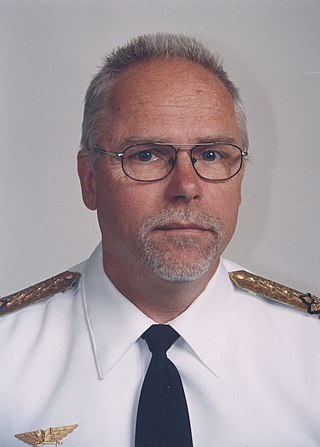
Lieutenant General Kent Holger Harrskog is a retired Swedish Air Force officer. He was Chief of Air Force Command from 1994 to 1998 and military commander of the Southern Military District from 1998 to 2000.
Lieutenant General Jan Bertil Gustav Jonsson was a senior Swedish Air Force officer. Jonsson served as Inspector General of the Air Force from 1998 to 2000, as head of the Joint Forces Command from 2000 to 2007 as well as the Commandant General in Stockholm from 2006 to 2007.
Senior Colonel Rolf Nils Ove (Owe) Wagermark is a retired Swedish Air Force officer. Wagermark commenced his military journey in the Swedish Air Force, starting at Roslagen Air Corps. Graduating from the Royal Swedish Air Force Academy in 1973, he served in various capacities, including Tactical and Air Defence Control System units. Noteworthy achievements include ranking top in advanced courses at both the French military schools, École militaire and École supérieure de guerre interarmées, marking the first time a Swedish officer claimed the top position in France. Wagermark served as ADC to Prince Bertil, Duke of Halland, and held significant roles in recruitment and information management within the Swedish Armed Forces. He served as Deputy Inspector of the Air Force from 1998 to 2000.















